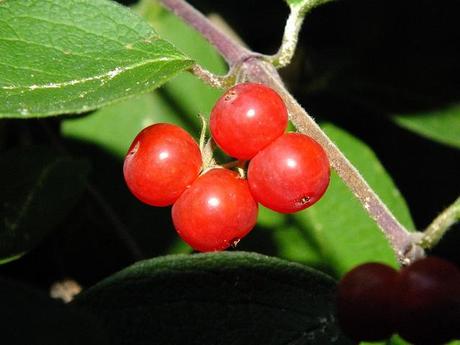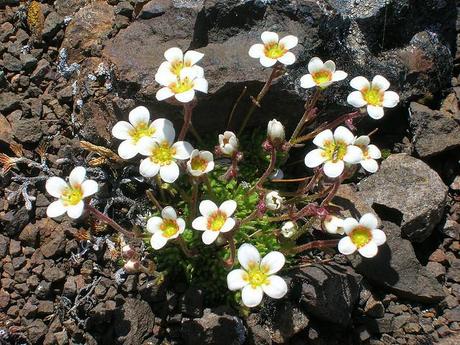The tundra only has what would normally be considered a growing season for two months of every year. Despite the almost year round freezing temperatures, the tundra biome is thriving with a surprising variety of plant life. What you won’t find on the tundra are trees. After all, that is how it got its name – tundra comes from the Finnish “tunturia” which means treeless land. The winds are harsh here, and most of the plants that grow on the surface of the tundra grow in clusters to form a natural barrier against the wind.
There are over 400 different types of plants that bloom on the tundra, but few plants that are associated with year round growth. One of the issues with plants growing on the tundra is the nature of its soil. While there is a thick layer of soil beneath the ice, it rarely thaws beyond a few inches. This means that only plants with the shallowest roots can take hold.
The fact that plant life is present, but not always lasting plays an important role in sustaining the other life forms that live in this biome. As the plants die and decay, many of the other organisms will use them to nourish themselves during the long winter months.
Here is a list and brief description of the common plants you will find on the tundra that are perennials.

Bearberry
Bearberry isn’t really all about bears, although they have been seen to eat them. The red berries and green leaves attract the owls and birds that come to the tundra. The plant has uniquely adapted to the tundra by growing very low to the ground. It is not quite a ground cover, as it does have some height. It can have berries on it year round.
Labrador Tea
The Labrador Tea is a strange little plant with red leaves and what can only be described as hairy legs. The stems of the plant are covered with a fine type of hair-like growth that helps it to conserve heat. Unusual about this plant is that it is not consumed by any of the animals on the tundra.
Diamond Leaf
The Diamond leaf is a form of willow, but not like the willows that you may be used to. These are not tall willows but they grow close to the ground. Like the Labrador, they also have a hair-like growth that covers their stems and roots that help the plant to stay warm. This plant is also edible and gathered by people and animals because it is rich in calcium and many vitamins. The plant is also very flexible so it is not found in groupings but grows separately as it can bend to manage the harsh winds.
Arctic Moss
Artic Moss is the most plentiful plant on the tundra and it is not quite unlike the moss that grows elsewhere in other biomes. It can grow on the surface but is primarily an aquatic plant that grows beneath the surface of the water. It does not have a root systems but rhizoids. It is also covered in small leaves that are only one cell in thickness, which makes it easy to sustain itself with the very limited amount of photosynthesis it can glean.
Artic moss is a mainstay of many of the animals and mammals in the tundra as it is rich in nutrients and can grow all year long. When it dies, it also becomes an important source of nutrient for other organisms that thrive there. It is also an important food source for birds that pass through the tundra on their migratory paths. It is a favorite study subject of scientists because it reveals much about the natural evolution of life to protect itself in harsh climates.
Arctic Willow
Arctic willow or rock willow is normally found in North America tundra region which consists of Northern Canada and Northern Alaska. Arctic willow is 15-20 cm in height, has long trailing branches and grow prostrate, shrub, and carpet.
Caribou Moss
Caribou Moss grows in arctic and northern regions around the world. They grow on ground and on rocks and can go up to1-4 inches high. They go dormant when there is no light or water. They can grow again after being dormant for a very long time. The stems or stocks of caribou moss are hollow.

Tufted Saxifrage
Tufted Saxifrage grows on thick stems and has several straight flower stems that can go as high as 3-15 cm. Each stem has around 2-8 flowers and each flower has five white petals. Tufted Saxifrage also has a small fruit that holds many small seeds. The Tufted saxifrage grows on the rocky slopes and can be found from Alaska to the Cascade and Olympic Mountains and northwestern Oregon.
Pasque Flower
Pasque Flower is a member of the Ranunculaceae family and can grow 6-8 inches off the ground. On each stem, it has one flower with 5-8 petals. The color of flower range from lavender to almost white. Pasque Flower grows on southward facing slopes and is common throughout northwestern U.S. up to northern Alaska. It is also the state flower of South Dakota.
There are other plants and flowers that can be found growing on the tundra that will vary according to the season and the location of the tundra climate. The main plants listed are considered to be most definitive of the tundra climate. Variations of these plants are found in different biomes, which also allows scientists to study the spread of plant life via migratory animals as well.

